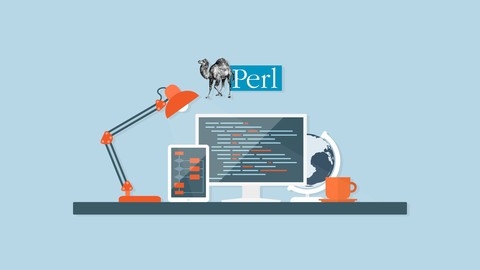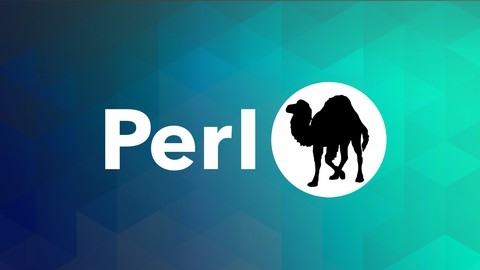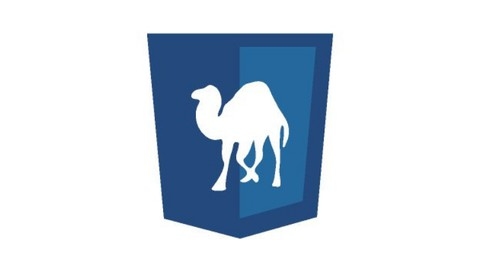Perl is a powerful and versatile programming language used for a wide range of tasks, including web development, system administration, and data analysis.
Mastering Perl can open doors to exciting career opportunities in various fields.
Finding a good Perl course on Udemy can be challenging, as there are many options available, each with its own strengths and weaknesses.
You’re looking for a course that is comprehensive, engaging, and provides practical experience, but also fits your learning style and goals.
For the best Perl course overall on Udemy, we recommend Learn Perl 5 By Doing It.
This course emphasizes hands-on learning, guiding you through practical examples and projects that solidify your understanding of core Perl concepts.
From basic installation and text editing to advanced topics like web scraping, database interaction, and object-oriented programming, this course provides a comprehensive and engaging learning experience.
While Learn Perl 5 By Doing It is our top pick, there are other great options available.
Keep reading to discover our recommendations for different learning styles and goals, including courses for beginners, intermediate learners, and those seeking to master specific Perl techniques.
Learn Perl 5 By Doing It
You’ll start with the basics of installing Perl and using text editors, then quickly dive into core concepts like arrays, hashes, regular expressions, and file operations.
The course takes a hands-on approach, guiding you through practical examples of downloading text and images, reading and writing files, and manipulating data using powerful regular expressions.
You’ll learn techniques like greedy vs. non-greedy matching, escape sequences, and numeric quantifiers, solidifying your regex skills with tests along the way.
As you progress, you’ll tackle more advanced topics like web scraping, parsing complex data structures like CSV and XML, and working with databases using MySQL.
The course even covers object-oriented programming in Perl, giving you a solid foundation in modular and reusable code.
You’ll also learn how to build command-line tools and web applications using CGI, a crucial skill for any Perl developer.
And for those interested in system administration, the course covers essential tasks like moving, copying, and deleting files, as well as executing system commands.
Throughout the course, you’ll work with real-world examples and data, ensuring that you gain practical experience in addition to theoretical knowledge.
Perl Programming for Beginners
This course starts with the basics of installing Perl and creating your first program, gradually building up to more advanced topics.
You’ll learn how to work with scalar data like strings, numbers, and variables.
The course covers getting user input, using the chomp operator, and making decisions with if statements and loops like while.
Arrays and lists are explored in-depth, including creating them, accessing elements, converting between arrays and strings, and using foreach loops.
You’ll understand scalar and list context, an important Perl concept.
Subroutines are covered thoroughly - defining them, calling with arguments, returning values, and using private variables.
This is a core aspect of writing modular Perl code.
The course dives into input/output, teaching you to get input, format output with printf, work with filehandles, and handle errors with die.
You’ll learn to use powerful hashes - Perl’s built-in key/value data structure.
Regular expressions are a major focus, with multiple sections dedicated to pattern matching, character classes, substitutions, splitting strings, and more.
As regex is central to Perl, this is invaluable.
Finally, you’ll apply what you’ve learned to a final project, with the steps explained in detail.
Enhance Your Skill Set with Perl
You will start by learning how to install Perl on different operating systems like Unix, Linux, and Windows.
The course will then take you through the fundamentals of Perl, including creating your first program, working with numbers, strings, and user input.
You will dive into control structures like if statements and loops, which are essential for writing complex programs.
The course covers arrays in depth, teaching you how to create, manipulate, and iterate through them.
Subroutines, which are reusable blocks of code, are also covered, allowing you to write more modular and maintainable programs.
The course dedicates a significant portion to input/output operations, teaching you how to read from and write to files using file handles.
You will also learn about hashes, which are key-value data structures, and how to use them effectively in your programs.
Regular expressions, a powerful tool for text manipulation, are covered in detail.
You will learn how to match, split, and substitute text using various regular expression patterns and modifiers.
The course introduces you to Perl modules, which are pre-written code libraries that extend Perl’s functionality.
You will learn how to install and use modules, as well as how to create your own modules.
References, a powerful feature of Perl, are also covered.
You will learn about different types of references, such as scalar, array, and hash references, and how to use them effectively.
The course delves into file tests, which allow you to gather information about files, such as their size, age, and type.
You will also learn how to work with directories, including creating, deleting, and traversing them recursively.
Advanced sorting techniques are covered, enabling you to sort data in various ways, including sorting hashes and unconventional data structures.
Throughout the course, you will have the opportunity to practice your skills with numerous exercises and coding challenges.
The course provides solutions to these exercises, allowing you to reinforce your understanding and compare your approach with the provided solutions.
Power of Perl :: Learn Basic and Advanced Perl Programming
You will start by learning how to set up Perl on your system and write your first program.
The course then dives into the fundamentals, including data types, operators, loops, conditional statements, and subroutines.
A significant portion of the course is dedicated to regular expressions, which are essential for text manipulation and pattern matching in Perl.
You will learn how to use regular expressions effectively and master advanced techniques.
Moving on to more advanced topics, you will learn how to read and write files in Perl, as well as how to work with spreadsheets.
The course covers reading and writing spreadsheet data, as well as formatting spreadsheets using Perl.
The course also introduces you to SQL basics and teaches you how to interface Perl with Microsoft SQL Server.
This is a valuable skill for working with databases in Perl.
Finally, you will get a brief overview of HTML and learn how to create Perl modules and generate HTML content dynamically.
Throughout the course, you will gain hands-on experience with Perl programming through practical examples and exercises.
Perl for Beginners: Learn A to Z of Perl Scripting Hands-on
You will start by learning how to download and install Perl on your system, along with the necessary resources like PowerPoint presentations and code files.
The course then dives into the fundamentals of Perl, covering variables, strings, scalar variables, and string manipulation techniques.
You will gain a solid understanding of operators in Perl and learn to work with arrays, including array basics, built-in array functions, and array traversal methods.
The course also covers hashes in depth, teaching you hash basics, built-in hash functions, and hash traversal techniques.
Conditions and loops are essential concepts in programming, and this course dedicates multiple lessons to help you master them in Perl.
You will learn about different types of conditions and loops, as well as how to use them effectively in your scripts.
Regular expressions are a powerful tool in Perl, and the course provides a comprehensive introduction to them.
You will learn how to use regular expressions for pattern matching, text manipulation, and data validation.
The course also covers subroutines, which are essential for modularizing and organizing your code.
You will learn how to define and call subroutines, pass arguments, and work with built-in subroutines.
Variable scoping and importing modules are important concepts in Perl, and the course covers them in detail.
You will learn about different types of variable scopes and how to import modules into your scripts.
File handling is a crucial aspect of many programming tasks, and this course teaches you how to read from and write to files in Perl.
You will learn about different file handling techniques and how to work with files efficiently.
Finally, the course introduces you to references in Perl, including hard references and symbolic references.
You will learn how to use references to create complex data structures and pass data between subroutines.
Learning Perl by Example
This course starts with an introduction to Perl, covering its features and how to write basic scripts.
You’ll then dive into working with different data types like scalars (numbers and strings), arrays, and hashes (key-value pairs).
The course teaches you how to control the flow of your programs using control structures like if/else statements, loops, and more.
You’ll also learn file input/output operations, allowing you to read from and write to files.
A major focus is pattern matching using regular expressions, which are essential for text processing tasks.
You’ll learn how to match patterns, extract data, and perform substitutions on strings.
Moving on, you’ll explore subroutines (reusable code blocks), functions, and modules (pre-written code libraries), which are crucial for writing modular and maintainable code.
The course covers built-in operators and functions in Perl, giving you a solid understanding of the language’s capabilities.
It then introduces object-oriented programming concepts, allowing you to create and work with objects.
Towards the end, you’ll apply your knowledge by building practical projects involving sockets (network programming) and databases using Perl’s DBI (Database Interface) module and SQL.
Throughout the course, you’ll work on quizzes and exercises to reinforce your understanding of the concepts covered.
Perl Fundamentals
You will start by learning the fundamentals, including literals, variables, string functions, conditionals, and loops.
These core concepts lay the foundation for writing Perl programs.
Next, you will dive into data structures, a crucial aspect of any programming language.
The course covers lists, which allow you to store and manipulate collections of data.
You will also learn how to work with command line input and file input/output, enabling you to read data from and write data to files.
Additionally, you will explore hashing, a powerful technique for organizing and retrieving data efficiently.
Moving on, the course delves into subroutines, which are reusable blocks of code that can be called from different parts of your program.
You will learn how to define subroutines, pass arguments to them, and handle return values.
This modular approach to programming promotes code reusability and maintainability.
Regular expressions are a powerful tool for text manipulation, and this course dedicates a significant portion to teaching you how to use them effectively.
You will learn about simple regular expressions, metacharacters, and various text manipulation techniques using regular expressions.
Throughout the course, you will encounter hands-on exercises and review questions to reinforce your understanding of the concepts covered.
The Complete Perl Programming Course
The course starts by introducing you to Perl and its history.
You’ll then set up your environment to start learning Perl.
The basics are covered in three parts - operators, statements, and assignments.
You’ll apply what you’ve learned by building a number guesser program.
Next, you’ll dive into subroutines and strings.
After a quiz, you’ll learn error handling and working with files and directories over two sections.
Arrays and lists are explored in-depth across four sections, followed by an assignment.
The course then moves on to hashes, classes, and roles.
Another quiz tests your understanding.
You’ll learn about junctions, sets, regex, and grammars - covering grammars across four sections.
You’ll work with supplies, channels, and promises.
Controlling external programs is also covered.
The third quiz reinforces these concepts.
The course culminates in a course project where you’ll build a log analyzer, applying the skills you’ve acquired throughout the lessons.
Key topics like operators, files, arrays, hashes, regex, and grammars are explored comprehensively.
You’ll gain hands-on experience through projects like the number guesser and log analyzer.
Perl Programming
The course begins with an introduction to Perl, guiding you through writing your first “Hello World” program.
You’ll then dive into operators, which form the foundation for performing operations in Perl.
Next, you’ll explore conditionals, a crucial concept for controlling the flow of your programs based on certain conditions.
Arrays are a fundamental data structure in Perl, and the course dedicates several sections to working with arrays.
You’ll learn about for loops, which allow you to iterate over arrays and perform actions on each element.
The course also covers array operations, such as pushing and popping elements, as well as array functions that simplify common tasks.
String manipulation is another important aspect of programming, and you’ll learn about string functions that enable you to perform various operations on strings.
Throughout the course, you’ll gain hands-on experience with Perl programming concepts through practical examples and exercises.
Getting Started with Perl for Beginners
This course starts by covering the basics of Perl programming.
You’ll learn how to install Perl and write your first “Hello World” program, including the shebang line.
The course then dives into the fundamentals of Perl syntax, such as whitespace rules, semicolons for ending statements, and scalar variables.
You’ll also learn how to add comments to your code, take input from the console using chomp, and perform basic math and string operations.
The course covers conditional expressions and comparison operators, which allow you to control the flow of your program based on certain conditions.
Additionally, you’ll understand how Perl evaluates values as true or false in boolean contexts.
The early sections lay a solid foundation by introducing you to the core building blocks of Perl programming.
You’ll learn the syntax and concepts necessary to write basic Perl scripts, setting the stage for more advanced topics later in the course.










